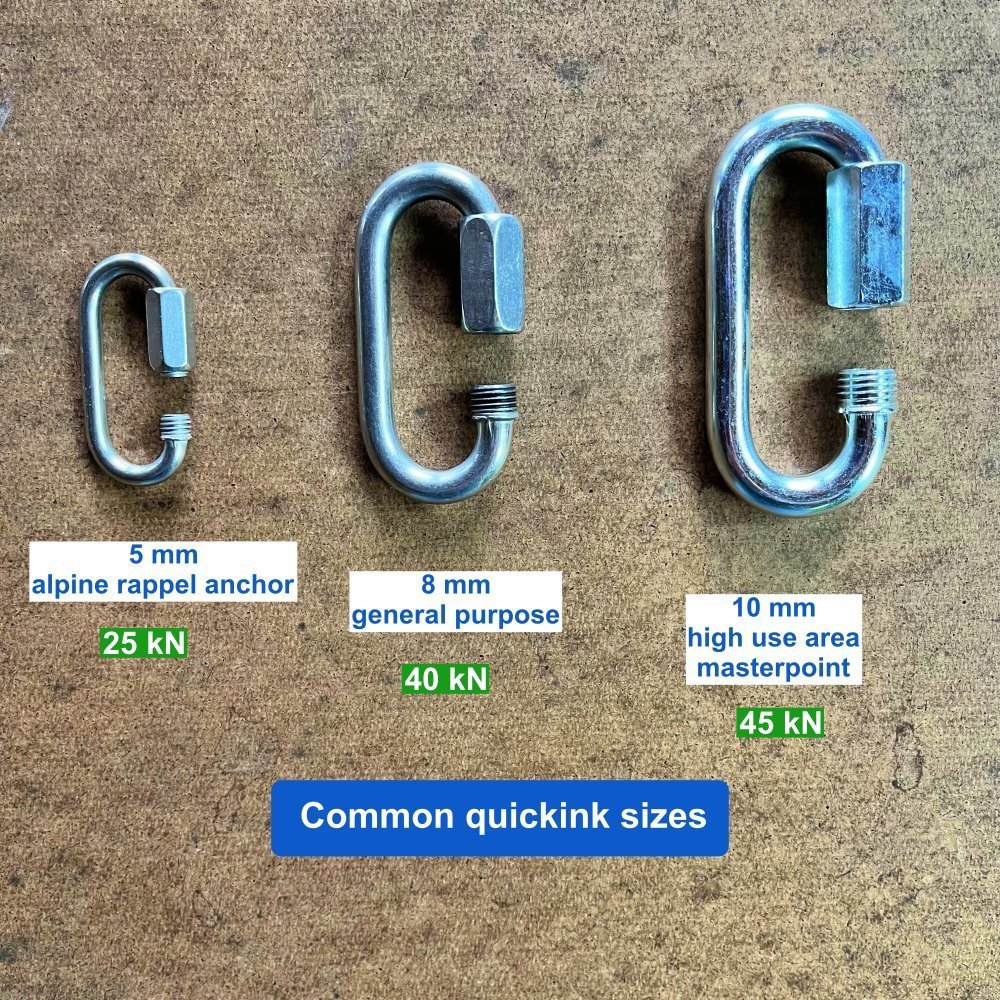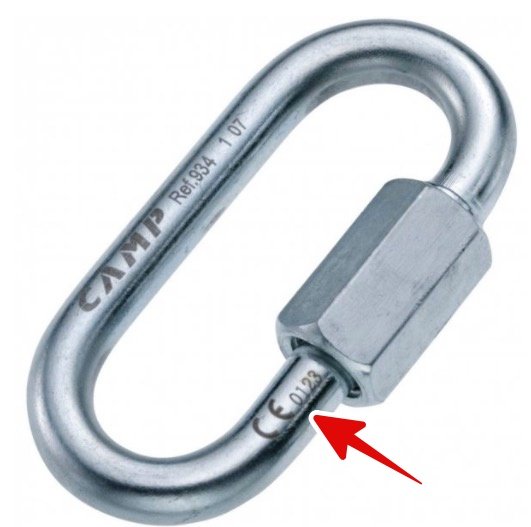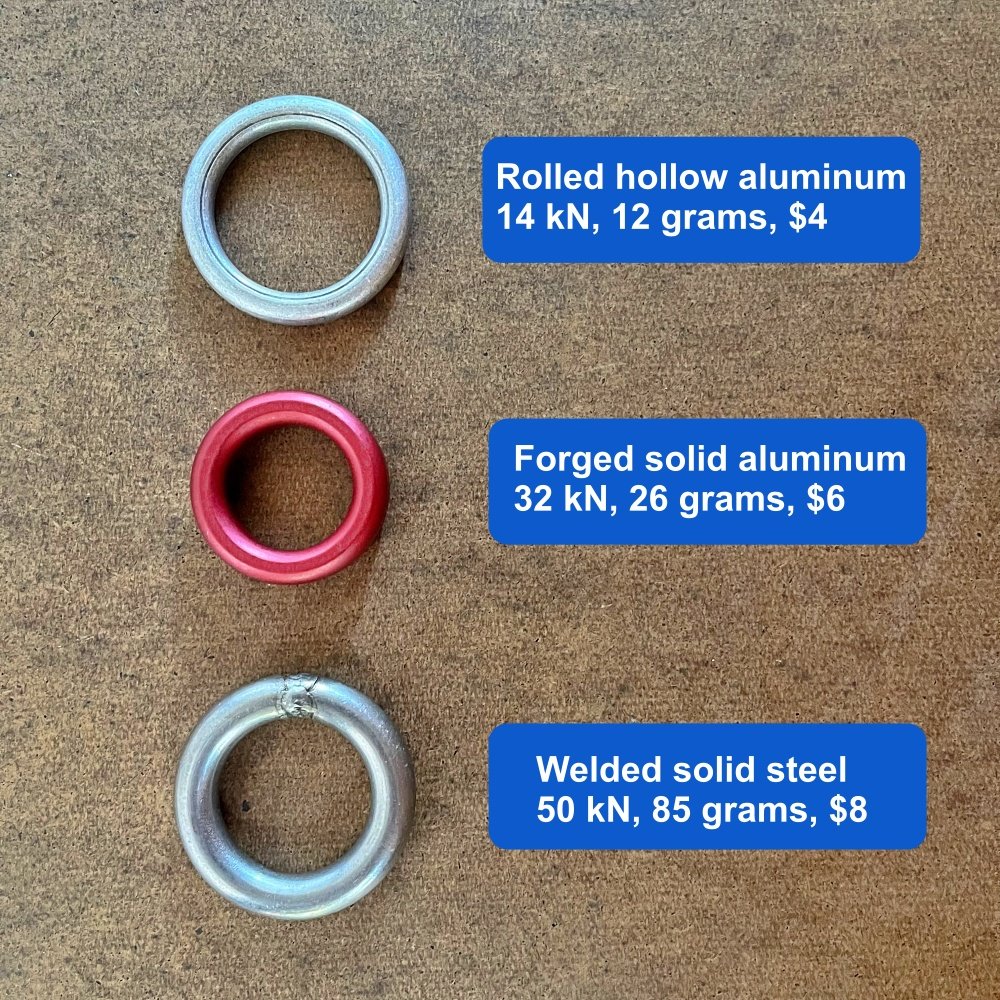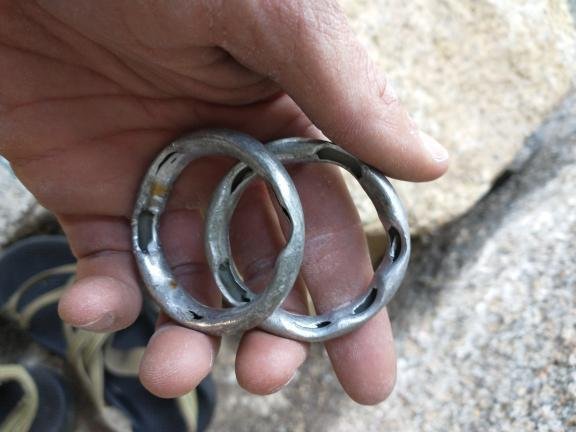Rappel hardware pros and cons
You can set up a rappel (but NEVER a toprope!) by running your rope directly through the webbing. But, it's usually preferable to have some sort of metal connection to the rope, which gives a much easier rope pull and does zero friction damage to the anchor slings.
Keep in mind that the maximum force possible on a rappel anchor it is only about 2 Kn, so the hardware does not have to be especially burly, But it sure can give you more confidence if it is! (See lots more climbing gear strength ratings at this link.)
This usually means one of three things: a quicklink, a rappel ring, or a carabiner. Let's have a look at the pros and cons of each one.
1 - Quicklink
A quicklink (aka “maillon”) is a single link of metal chain that has a threaded sleeve, which can be opened and closed. They come in various diameters. Use the smallish ones (5mm) if you choose to take one on an remote alpine climb, and maybe a 10 mm big fat one if you're being a good Samaritan and replacing anchors at your local crag. The 8mm are a good in-between size for general use. They can be made with a zinc plating (for indoor use) or stainless steel. Please use stainless steel hardware for outside anchors!
Note: When possible, use quick links that are CE rated for climbing. The Italian company CAMP sells them and they are inexpensive, insanely strong, and come in 5 mm, 8 mm, and 10 mm. We have a whole article on that here. This is a better option than random hardware store quick links of questionable lineage.
Note: It's best practice to close the sleeve of the quick link by screwing it down toward the ground. This means that gravity is helping keep the sleeve closed. A little pneumonic to help remember this is: “Screw down, so you don't screw up.” If you have a quicklink that you want to fix it more permanently, give it an extra turn with a pair of pliers; a multi-tool is your friend. And if you really want to secure it, add a few drops of thread lock.
If you’re doing Crafty Rope Tricks like rappelling with a knot block, then the very small diameter opening may make the quick link your preferred option because it can block the knot. This is an advanced maneuver that requires some specialized knots and training, beyond the scope of what I want to explain here. If you're curious about this type of rope trickery, see this YouTube video, “StaticBlocks - setting the rope length.”
It's probably not worth carrying a quick link as a “just in case” piece of gear on your harness on every climb. It's heavy, single use, and if you need an emergency rappel anchor, a carabiner usually works just fine.
Sidenote: if you’re retreating from a sport climbing route, please don't use a quick link to lower from. They are much harder to clean for the next person up. Try a carabiner instead.
A lightweight option is an aluminum quick link. These currently come in at 7 and 10 mm sizes. The 7 mm is not officially rated, but sources that say they break around 12 kN. Not anywhere close to the 40+kN of a steel 8 mm, but certainly adequate for a rappel anchor.
The 7 mm one weighs only 18 grams, which is dramatically lighter than the almost 80 grams of an 8 mm steel link.
These can be a bit hard to find online, but my buddy Ryan at howNOT2.com usually has them in stock; here's a link.
Pros:
Handy when you want to pass the quick link around several existing slings on an alpine anchor
Small narrow opening, which prevents the knot on a double rope rappel or knot block from ever passing through it
Inexpensive
Insanely strong; the 8 mm CE rated CAMP quicklink is rated to 40 kN!
Cons:
Most are hardware store varieties not rated for climbing, probably made in a random machine shop in China
Somewhat heavy, single purpose piece of gear
2 - Rappel rings
A rappel ring is a round, smooth ring, made of aluminum or steel. All are plenty strong and inexpensive. Again, like the quicklink, rings are something that you probably don’t need on every alpine climb. If you anticipate doing multiple rappels on a seldom climbed route, and weight is not a huge concern, you might want to bring a couple.
Pros:
Properly engineered for climbing and rigging, a single ring is plenty strong
Cons:
Can’t pass the ring around several slings on an existing anchor (Although you can girth hitch a rap ring around a sling, see this tip). Note that this girth hitch technique is more than a little sketchy!
Again, a single purpose piece of gear
Rolled aluminum ring
These are made of rolled metal, as you can see from that thin line in the middle. They are hollow, and (per Andy Kirkpatrick) are only about one millimeter (!), which does not fill me with a great deal of confidence. However, when new, they are rated at 14 kN, even if they do not give me a warm fuzzy feeling if rapping from just one of them. If you find them in the wild, consider replacing them if you have something better. Or at least double them up. Try to use these only for rappelling and not lowering, that will help them last much longer.
Best use: retreat anchors, or on remote alpine raps that are not going to get much traffic and not on common routes. Apparently they’re also good for hanging hammocks. =^)
Yikes! This is what you don't want to find at a rappel station, and why hollow aluminum rings don’t belong on busy routes. These were removed from a popular route in Yosemite. Don’t be a cheapskate. Replace time bombs like this whenever possible. Ryan Jenks at HowNot2.com tested a worn out ring like this, and it broke at 1.5 kN! Death trap! Photo: shared by AMGA Certified Rock Guide Kevin Heinrich, used with permission, @kevhamrich
Photo: Kevin Heinrich, @kevhamrich
Forged aluminum ring
These are solid aluminum all the way through, unlike the hollow ring above. Plus, they come in cool anodized colors. =^) They are insanely strong, and cost just a dollar or two more than the rolled aluminum ones shown above. I would call these modern standard, and if you're considering aluminum rings, these are the way to go. This one is from SMC, they make some excellent gear. Cheap, strong, and light, I love it!
Best use: rappel master point in moderate use alpine routes, still not great to lower on. Just like a quicklink, you’re fine rapping off one of these.
Welded steel ring
Made by Fixe and other companies. Ridiculously strong. HowNot2.com tested two of these; one broke at 90 kN and the other at 47 kN.
Best use is in popular sport climbing areas (okay to lower from) not for distant alpine routes. Still fairly inexpensive, around $7-$8.
Rappel ring break test results from HowNottohighline
image: https://www.instagram.com/p/CmKFzXmvIqp/?hl=en
3 - Carabiner
Leaving a carabiner behind will tear at the soul of the frugal dirtbag climber, but come on, it's only about five bucks, relax. Remember all those clunker cheapo carabiners you probably got when you first started climbing? If you’re planning an alpine route where you anticipate lots of rappels, bring a couple of those along as a “leaver carabiner” and slowly dispose of them.
While a single carabiner generally fine to rappel off of, many people will prefer the extra security and use two regular carabiners with gates opposite and reversed. Or leaving a locking carabiner. Or, you can always use my favorite method: take one snapgate carabiner and tape the gate shut, making a cheapskate locker.
Pros:
You always have it with you
Multi purpose price of gear
Easy to clip to multiple webbing strands on an alpine anchor
Cons:
A bit more expensive than the other options
The wide gate might cause the knot connecting your rappel ropes to migrate through it, making pulling the rope more difficult. Knot blocks may not work. Be cautious with skinny double rope rappels
A single standard carabiner with the gate not taped is not the safest setup. Better to use a locker, two with gates opposite and reversed, or tape the gate shut
The cheapskate locker. A few wraps of tape completely secures the gate, and gives you peace of mind for a rappel. Leaving a little extra tape folded over makes it easy to remove.
So . . . Where does that leave us? It really comes down to personal preference. Each one of these is plenty strong, relatively inexpensive, and will give you a smooth rope pull. Personally, I dislike carrying special use pieces of gear that I may or may not use, so I usually use a “cheapskate locker” carabiner taped closed for a standard rappel. I’ll sometimes bring a quicklink if I anticipate a knot block or some other Crafty Rope Trick may be needed.








